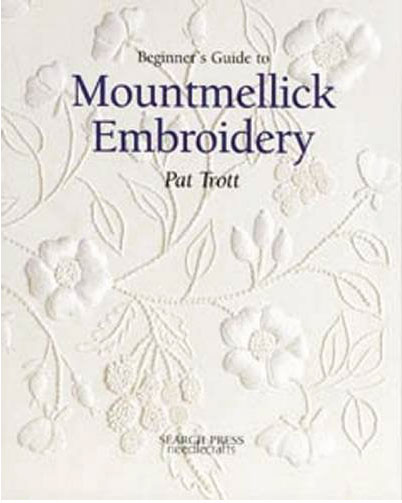Do you ever cringe at the thought of giving your hand-embroidered masterpeices a good washing – in fact, washing them over and over and over gain?
Way over in Ireland, there’s a place called Mountmellick, where, in the early 1800’s, a school was established to teach an affordable embroidery technique to women and girls.

What is it that makes Mountmellick embroidery different from other types of whitework?
There are actually several aspects of Mountmellick embroidery that differentiate this technique from other forms of whitework.
First of all, Mountmellick is not done on linen. Rather, authentic Mountmellic fabric is a heavy cotton jean fabric (not denim, really) – with a nice sheen on the back of it, the side on which the embroidery is done.
It’s a durable fabric, and it stands up to laundering. The more it’s washed, the shinier it seems to become.
While the material has a nice sheen, the thread is actually matte. This nice contrast is a trademark of real Mountmellick work. In fact, in the era of mercerized cotton (which has a chemically-induced shine), it can be hard to find the proper threads for real Mountmellick work.
Good thing there’s Lacis, which does have the matte thread. (Look under embroidery cotton).
In many forms of whitework, the designs are somewhat delicate, and cutwork or openwork is often involved. In Mountmellick Embroidery, the designs are definitely bold, and cutwork and openwork are never involved – it’s all straight surface embroidery.
The common motifs in Mountmellick Embroidery are taken from nature – flowers, berries, brambles, leaves, stems, etc. The typical stitches are satin stitch (padded), stem or outline, Mountmellick stitch, knots, feather stitch, and buttonhole, and variations on all of these.
The edges in Mountmellic embroidery are generally finished with buttonhole stitch or with fringe, depending on how the stuff is to be used.
The type of embroidery that flourished in Mountmellick was originally intended to help poor Irish women and girls survive the austere living of the Industrial Age in Ireland. The supplies were inexpensive (not so today – if you want the “real stuff” when it comes to Mountmellick fabric, you’ll pay anywhere from $30 – $50 / yard for it), and the goods were sold, often to visiting Americans, from whence the technique spread in popularity.
It’s still a popular technique, and in the embroidery world, it’s enjoying a renewed interest.
If you’d like to give Mountmellick embroidery a try, I suggest starting with Pat Trott’s “Beginner’s Guide to Mountmellick Embroidery.”
It’s very practical and down-to-earth. She’s got great suggestions for framing up your work for stitching, and a nice selection of authentic patterns and stitches.
The instructions in the book are very easy to follow, and you’ll master the basics of Mountmellick whitework in no time with Pat’s clear instructions and beautiful designs!
Where to Find It
You can find Beginner’s Guide to Mountmellick Embroidery through the following book affiliates:
In the US, Beginner’s Guide to Mountmellick is available here through Amazon.
Worldwide, you’ll find Beginner’s Guide to Mountmellick available here through Book Depository, with free shipping.







superb and very eloborative tutorials. i find no words to express my utmost excitement getting all stitches that i looked for. i am an avid learner of embroidery. THANKS A LOT!!WONDERFUL WEBSITE.
fantasticas las puntadas ymuy bien explicadas felicidades y gracias muy buen trabajo los seguire tod el tiempo para aprender mas hasta pronto
This is a wonderful website I am a complete beginner and love it. The tutorial videos are amazing and I have learnt so much. I love it.
gracias por estos videos tan espectaculares. donde puedo encontrar el paso a paso del bordado mountmellick, la verdad me interesa mucho este bordado. vivo en colombia,sera que puedo comprar un libro y donde. mil gracias. quien pueda ayudarme le agradecere toda la vida. mil bendiciones
amazing. truly amazing. you have collected so much information on hand embroidery. this will be helpful for many generations.
Mountmellick embroidery or Mountmellick work is a floral whitework embroidery originating from the town of Mountmellick in County Laois, Ireland in the early nineteenth century.
Hello Mary,
I want to embroider just a single rose in mountmellick style; I know what to choose for stems but I don’t know which stiches to use for the bud and leaves; it’s a large pattern so I want parts of the design to be empty; thank you very much !
Mary, I thought the main difference between just white work and Mountmellick was the fact that Mountmellick didn’t have the cutwork or pulled thread. I think I am really confused now.
If you could clarify this. Thanks.
Ren
I would like to know what the name of a certain design is. You take a piece of cardboard. Mark the four corners, and then make it at equal points. You then make stitches and back loop stitches to fill it looks something like tatting as Colonia stitchery. The designs are beautiful. I would like to know the name and how to mark off the squares. It has been several years since I did it.via you can help that would be wonderful. I don’t know if it is English or French.
I was practicing the Mountmellick stitch but something just wasn’t right — it looked awful, not at all like Mary’s. So, I watched this video and it all became clear to me. I am ready to do a little practice with my new knowledge and then on to the real thing. Thanks so much for the clear demo.